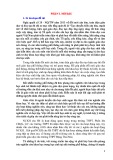
Collaboration for Agriculture and Rural Development
(CARD)
Program
218
REPLACING FERTILISER N WITH RHIZOBIAL INOCULANTS
FOR LEGUMES IN VIETNAM
Project title:
Replacing fertiliser N with rhizobial inoculants for legumes in Viet
nam for greater
farm profitability and environmental benefits
Project code
:
CARD
013/06VIE
Authors:
Tran Yen Thao
1
, Prof. Dr. Pham Van Toan
2
, Prof.Dr. Pham Van Bien
3
, Dr. David
Herridge
4
, Rosalind Deaker
5
Project implementing organizations:
1
Research
Institute for Oil and Oil Plants (IOOP)
2
Institute of Soils and Fertilizers (ISF)
3
Institute of Agricultural Science of South Vietnam (IAS)
4
NSW Department of Primary Industries
5
University of Sydney
SUMMARY
The overall objective of the project was to
decrease the use of N fertiliser used on legume crops
soybean and groundnut in Vietnam by increasing adoption of legume inoculants. Replacing N
fertiliser with legume inoculants will provide both economic and environmental benefits to farmers
and alleviat
e financial stress for poorer farmers by reducing input costs.
The approach was to increase awareness and demand for inoculants through an extension program
including direct demonstration of the benefits of inoculants and training in their function and u
se.
Simultaneously, a technical program targeted at increasing the production capacity of high quality
inoculants in Vietnam was initiated. This included development of inoculant formulation suited to
Vietnamese conditions, a system for quality control t
o ensure farmers would have access to high
quality products and technology transfer to the commercial sector to scale up production to meet
demand.
The project has been successful in achieving its goals. A survey of farmers and extension officers at
the b
eginning and end of the project indicated a clear increase in the awareness of the benefits of
inoculation and demand for their availability in the market. Over the two years of the project,
inoculant product formulation development reached a point where
peat
-
based inoculants could be
produced with consistently high quality by the research institutes. On
-
going research and
development will continue to improve formulation technology to meet requirements of large scale
production. Following a series of tra
ining workshops and capital investment a quality control
laboratory was established at IOOP and national standards were modified to more specifically
address issues relating to legume inoculant quality. The proposed standards define quality standards
as w
ell as quality control protocols.
The private sector was engaged in inoculant production, distribution and extension during the project
and foundations prepared for increasing involvement. Institutes have forged strong linkages with
private sector compan
ies and it is anticipated that effective relationships will continue to develop. A

CARD 013/06
–
Replacing fertiliser N with rhizobial inoculants
219
number of strategies have been proposed to allow future growth of the inoculant industry in Vietnam
including increasing profitability to the private sector by expanding th
e market either by expanding
the area for application or extending to the export market.
1.
Introduction
The Vietnamese government (MOIT, MARD)
is committed to increase the area sown to
legumes from the current 780,000 ha to
>1,000,000 ha by 2010, with
particular focus
on soybean and groundnut in the Mekong
Delta, the Central Coastal region and upland
(highland) areas of the North, Central and
North. The legumes are used for production of
food, oil and protein meal, and are grown as
rotation crops with r
ice (Mekong Delta), as
intercrops in the upland areas with cassava,
sugar cane, rubber, fruit and maize and as
cover crops in the sandy coastal soils. ACIAR
Small Project LWR2/98/27 (Increasing yield
and nitrogen fixation of soybeans, groundnuts
and mungbe
an in Vietnam through
Rhizobium
inoculation) identified that legume production
in Vietnam currently relies on expensive
imported fertiliser N, rather than cost
-
effective
inoculants containing rhizobia. Replacing
fertiliser N with rhizobial inoculants would
save Vietnamese farmers A$50
–
60 million
annually in input costs and, at the same time,
help facilitate the desired expansion in legume
production. There would also be positive
environmental outcomes.
Details of the economic benefits of replacing
fertilise
r N with rhizobial inoculation were
outlined in the proceedings of the technical
workshop to terminate LWR2/98/27. However,
for this to happen, high
-
quality inoculants need
to be readily available in the market. The
current capacity of inoculant production
in
Vietnam is about 40,000 packets annually, and
would need to be increased to about 500,000
packets annually to meet potential demand.
Inoculant quality is also poor (LWR2/98/27
project) and would need to be improved. Shelf
life and distribution and mark
eting are issues
that would also need to be addressed.
Moreover, there is limited awareness of the
benefits of inoculants and methods of
application among Vietnamese farmers and
extension workers.
Capacity gaps are evident at the national and
institutional
level. The major gap at the
national level is the lack of a coordinated,
focussed national legume inoculant program.
At the institutional level, the gaps are capacity
for medium
-
scale inoculant production and
associated quality assurance (QA) as well as
R
&D and training capacity. The proposed
project would address these issues of
production, quality, distribution and marketing
and farmer education. Involvement of the
private sector in both production and
marketing will ensure the long
-
term viability
of the
concept. The project objectives are to:
i.
Increase production of high
-
quality
inoculants for soybean, groundnut and
other legumes in Vietnam through
enhancement of production capacity
(personnel and equipment) at participating
institutions, implementation o
f QA, and
increased inoculant R&D;
ii.
Increase farmer interest and use of
inoculants in Vietnam through
development and implementation of an
effective extension and training program
on inoculants and legume nitrogen
fixation for researchers, MARD extension
of
ficers and farmers through
demonstration trials, workshops and
meetings, and publications;
iii.
Ensure the long
-
term viability of the
project through involvement of the private
sector in this ‘pilot production’ of legume
inoculants, with the aim that the privat
e
sector would progressively take over
production as the technology and markets
are developed.

Tran Yen Thao, Pham Van Toan, Pham Van Bien, David Herridge
&
Rosalind Deaker
220
2.
Project approach and methodology
The project strategy is to enhance inoculant
production, quality, distribution and marketing
and farmer education through th
e collaborating
institutions. It will involve both Government
institutions
–
Research Institute for Oil and Oil
Plants (IOOP), the Institute of Agricultural
Science (IAS) and the Institute for Soils and
Fertilisers (ISF)
–
as well as private sector
compa
nies (Fitohoocmon Fertiliser JSC, Cu
Chi Bio
-
Chemical Fertiliser JSC and Humix).
The latter would be involved initially in
marketing and distribution of inoculants and
would be provided with advice and technical
expertise to improve and expand their
inocul
ant production capabilities. In time, it is
envisaged that the private sector would take
over inoculant production, leaving QA to the
public institutions. Involvement of the private
sector in both production and marketing will
ensure the long
-
term viabilit
y of the concept.
Increased production of high
-
quality
inoculants and QA
Rhizobial strains for inoculant production
–
selection of strains from the collections in
Vietnam and/or other institutions, eg. ALIRU
(Australia), NifTAL (University of Hawaii),
Sura
naree University (Thailand).
Strain maintenance
-
Protocols and operation
manuals for maintaining strain effectiveness
and recognition to ensure stability of inoculant
quality during long
-
term storage were
developed and implemented.
Production technology
–
Draw on experiences
from Thailand and Australia to develop
production technology of inoculants at
medium
-
scale in Vietnamese institutes
through:
Modifications to broth formulations and
experiments in procedures for maintaining
sterility and dispensing b
roths into the
inoculant carrier.
Testing appropriate forms of inoculant (peat,
granular, liquid) that allow compliance with
quality control standards and are easy to use,
supply and transport. Economic benefits
will be determined by assessing their
effe
ctiveness in laboratory and field trials.
Strain selection: Different strains will be
tested for survival in inoculant products and
during delivery of products to the field.
Quality assurance
(QA)
-
Australian QA
protocols was used initially as a model. Fr
om
that, QA protocols, training and working
manuals specific to inoculant production in
Vietnam was developed jointly between
Australian and Vietnamese project scientists.
Training on inoculant production and QA
-
Vietnamese researchers from institutes w
ere
trained in Vietnam by Australian collaborators
and at Suranaree University of Technology
(Thailand) in inoculant production, QA and
laboratory management, as well as R&D in
rhizobiology.
Training on inoculant production and QA
-
Vietnamese researche
rs from institutes were
trained in Vietnam by Australian collaborators
and at Suranaree University of Technology
(Thailand) in inoculant production, QA and
laboratory management, as well as R&D in
rhizobiology.
Extension and training of farmers and
advis
ers
The extension
-
training program for farmers
and extension officers was built around simple,
multi
-
location inoculation experiments in the
legume production areas (Mekong Delta, the
Central Coastal region and upland (highland)
areas of the North and
Central and the South
East). They will involve participation of
farmers and extension officers in all aspects,
from the design of experiments to sowing,
sampling, harvesting and interpretation of
results. The MARD extension service played a
large role in e
xtension activities. Data from
field demonstrations was used to produce an
economic model for production and use of
legume inoculants in Vietnam. In addition,
training courses were organised for farmers,

CARD 013/06
–
Replacing fertiliser N with rhizobial inoculants
221
extension workers and researchers in methods
of inoc
ulant use, and economic as well as
environmental benefits of inoculation. This
extension
-
training program was conducted by
Vietnamese researchers in collaboration with
Australian counterparts.
Involvement of the private sector in
production, distribution a
nd marketing
Three Vietnamese companies who produce and
distribute biofertilizers were involved in the
project. Private sector was progressively
become involved as the production technology
was developed and the market for the
inoculants expanded. The com
panies were
initially involved in marketing and inoculant
distribution. Training workshops were open to
researchers from the collaborating private
companies.
3.
Research results and discussions
3.1
Increased production of high
-
quality
inoculants and Q
A
3.
1
.1
Strain selection
While there is specificity in the legume
-
Rhizobium
symbiosis, there are a range of
rhizobial strains capable of forming root
-
nodule symbioses within plant
-
host groups.
Inherent in this diversity is a range of
effectiveness in rel
ation to plant
-
growth
promotion through N
2
fixation. In this regard,
strains should be selected for commercial
production according to a set of criteria
including their effectiveness and
manufacturability.
Tests for effectiveness
In this project, elite in
ternational strains were
evaluated for their effectiveness in both potted
field soil and field trials across the country and
compared with national strains. Strains were
also compared in the laboratory for their
growth characteristics including any inheren
t
tolerance to temperature and pH. Included in
the studies were local and imported strains
from Vietnamese institutes, from NifTAL
(USA), ALIRU (Australia), DOA (Thailand),
Korea and Argentina. Several of these strains
are currently used in commercial ino
culants in
Australia such as CB1809 (soybean) and NC92
(groundnut).
In the potted field soil trials, 11 groundnut
strains for groundnut and 17 soybean strains
were tested against +N control without
inoculation and
–
N uninoculated control.
All
strains incr
eased groundnut and soybean
nodulation and yield compared to the control
treatments. As expected, there were close
correlations between nodule number, nodule
weight and plant biomass while correlations
between nodulation and plant height were
poor. Strains
producing the highest plant
biomass were NC92 (Australian commercial
strain), GL1 and GL2 (local strains) for
groundnut and CB1809 (Australian
commercial strain), SL2, SL1, CJ2 and U110
(old US commercial strain) for soybean.
The total number of field exp
eriments during
2007
–
09 was 36 in the 10 provinces. The
experiments were conducted in the main
legume
-
growing areas in Vietnam, from the
highlands in the North, to the Central Coast
area to the highlands in the South and Mekong
Delta. The provinces involve
d were Son La,
Nghe An, Binh Dinh, Binh Thuan, Dak
Lak,
Dak
Nong, Tay Ninh, Dong Thap, An Giang
and Tra Vinh. There were at least 5 treatments
in each experiment comparing CB1809, SL1,
SL2 (soybean); NC92, GL1 and GL2
(groundnut). Control treatments were f
armer’s
practice without N fertilizer and farmer’s
practice with N fertilizer.
The Australian strains were the most effective
in terms of nodulation, biomass yield and grain
yield. Compared with the uninoculated control,
CB1809 and NC92 increased nodulati
on of
soybean and groundnut, respectively, by an
average of 51%, biomass yield by 31% and
grain yield by 28%.
Compared to the local
Vietnamese strains, CB1809 and NC92,
increased soybean and groundnut nodulation
by an overall average of 22%. Biomass yields

Tran Yen Thao, Pham Van Toan, Pham Van Bien, David Herridge
&
Rosalind Deaker
222
were increased by an average of 12% and
grains yields increased by an average of 11%.
Tests for manufacturability
Strains were also compared for their growth
characteristics including rate of growth,
growth in different media and their ability to
grow and
survive at different temperature and
pH. Apart from a small increased tolerance to
low pH by local strains, growth of all strains
was comparable in all conditions indicating
that local strains were not any more tolerant to
stressful conditions than Austr
alian strains and
no survival advantage may be conferred
through their application. Media with more
affordable ingredients for large scale
production supported growth as much as the
benchmark medium yeast mannitol broth
(YMB) and may be adapted for large
scale
commercial production.
It was concluded that Australian strains NC92
and CB1809 were best able to meet the
selection criteria and that these should be
adopted as the commercial inoculant strains,
respectively for groundnut and soybean in
Vietnam.
In the future, more strain evaluation
will be done to develop even more effective
inoculant strains. It is also proposed that
cultures of these strains will be maintained,
authenticated and supplied annually from the
independent QA laboratory to private an
d
public sector laboratories producing inoculants
together with protocols for strain maintenance
and production of broth cultures.
3
.1.2
Institute capacity to produce high
quality of inoculants
During the almost three years of the project,
technology for
inoculant production at the
three institutes (SFI, OPI and IAS) was
developed. The principa
l aim was production
of high quality of inoculants containing
≥5 x
10
8
rhizobia/g and a maximum 1 x 10
8
contaminants/g. Different approaches were
taken to inoculant formulation development at
the collaborating institutes depending on
facilities and experti
se. To some extent, the
inoculant technologies have been adapted from
those used in countries with existing successful
inoculant industries, e.g. Australia, US. All
institutes investigated the use of peat as a
carrier and a range of peat from different
so
urces were tested for suitability.
Comparison of sterilisation techniques to
reduce contaminant load was done. Some
research on liquid inoculants was also carried
out.
Inoculant quality in Vietnam
Quality control of inoculants produced
throughout the pr
oject by the collaborating
institutes was carried out by IOOP. During
two years 2007
-
2008, a total of 261 samples
were tested over two years, 2007
-
2008 (from a
total of 465 samples received, 60 from IAS,
180 from SFI and 225 from IOOP). A total of
117 sam
ples were tested in 2007 and 144
samples in 2008. The number of rhizobia
ranged between <10
6
and >10
9
cfu/g inoculant
and number of contaminants between <10
5
and
>10
6
cfu/g However, the number of rhizobia
was high, between 5 x 10
8
and 3 x 10
9
cfu/g, in
the
majority of packets (72%), and
contaminant numbers were low (
≤10
6
cfu/g).
Plant
-
infection MPN counts indicated rhizobial
numbers ranging from <10
5
to >10
8
rhizobia/g
moist peat but as was the case with plate
counting, most inoculants (75%) had
≥10
8
rhizob
ia/g. Current standards for peat
inoculants in Australia and elsewhere are
≥
1x10
9
rhizobial cfu/g moist peat at the point of
manufacture and MPN plant
-
infection counts
are
≥10
8
. Therefore, in relative terms, a high
percentage of legume inoculants produce
d in
Vietnam already meet the high standards set in
other countries.
During 2009
-
2010, the QA program was
continued doing by checking inoculants
produced by participating institutes as well as
private companies (two companies in Nghe An
and Son La).
The
variation in rhizobial and contaminant
counts for the different batches resulted from
differences in procedures and expertise
amongst the three institutes. The number of


























